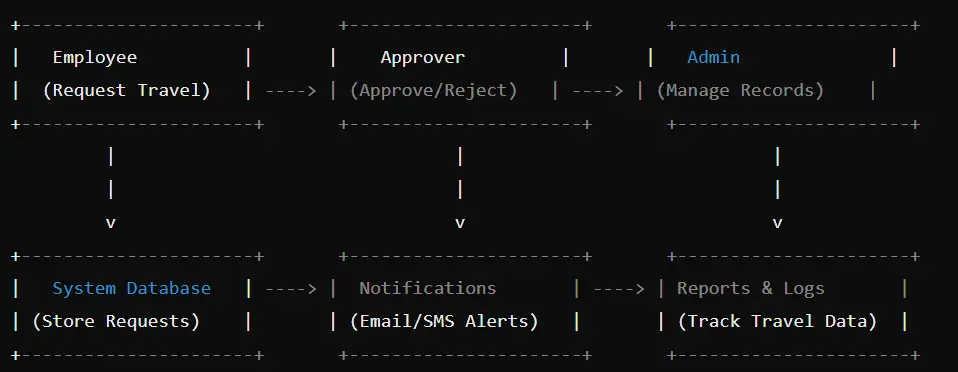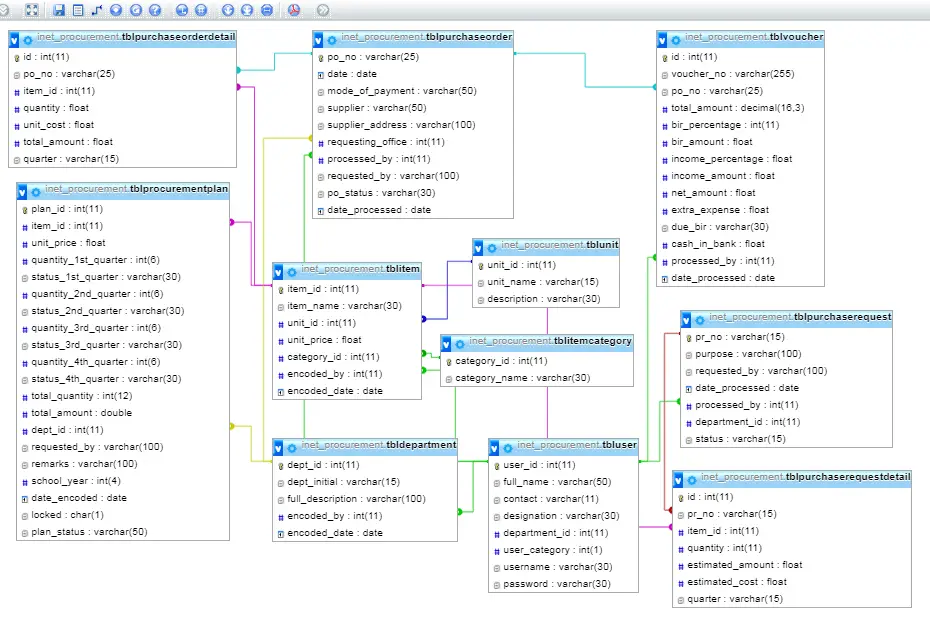Travel Order Logbook System
Introduction
Table of Contents
Managing travel orders is a crucial administrative task in organizations, ensuring that official trips are properly documented, approved, and monitored. Traditionally, many institutions rely on manual processes, such as paper-based forms or basic spreadsheets, to handle travel requests. These methods often lead to inefficiencies, including delays in approval, mismanagement of records, and difficulty in tracking expenses.
With the increasing need for streamlined administrative workflows, organizations are shifting towards automated solutions to enhance productivity and accountability. A Travel Order Logbook System serves as a centralized platform where employees can submit travel requests, managers can review and approve them, and administrators can generate reports for record-keeping. This system not only minimizes paperwork but also improves transparency, ensuring that travel orders follow proper authorization procedures.
By integrating technology into travel order management, organizations can reduce processing time, enhance data accuracy, and provide real-time monitoring of employee travel records. This study aims to develop a web-based Travel Order Logbook System that addresses the common challenges of manual travel order processing and optimizes organizational efficiency.
Objectives of the Project
The primary goal of this project is to design and implement a Travel Order Logbook System that addresses the inefficiencies of traditional methods. The specific objectives include:
- Automating the Travel Order Process: Developing a system that eliminates manual paperwork and streamlines the submission, approval, and tracking of travel orders.
- Centralizing Travel Order Management: Creating a unified platform where employees, managers, and administrators can access and manage travel orders in real time.
- Improving Efficiency and Transparency: Enhancing the speed and accuracy of travel order approvals while providing clear visibility into the status of each request.
Scope and Limitations
The Travel Order Logbook System will focus on providing core functionalities such as travel order submission, approval workflows, and logbook management. Key features include user authentication, role-based access control, and reporting tools for tracking travel history. The system is designed for use by employees, managers, and HR personnel within an organization.
However, the project has certain limitations. For instance, the system may not integrate with external platforms such as payroll or accounting software in its initial version. Additionally, the system is primarily designed for desktop use, and mobile compatibility may be limited. These limitations provide opportunities for future enhancements, such as mobile app development and integration with other enterprise systems.
Review of Related Literature and Systems
Existing Manual and Digital Travel Order Systems
Travel order management has evolved over the years, with organizations transitioning from manual to digital systems. Traditional manual systems rely on paper-based forms, physical signatures, and filing cabinets for record-keeping. While these methods are simple, they are prone to inefficiencies, such as delays in approvals, lost documents, and difficulty in retrieving historical data.
Digital travel order systems have emerged as a solution to these challenges. Many organizations now use spreadsheets, email-based workflows, or basic digital forms to manage travel orders. While these methods are an improvement over manual processes, they often lack integration, automation, and centralized control. For example, email-based systems can lead to cluttered inboxes and missed requests, while spreadsheet-based systems require manual updates and are error-prone.
Several commercial travel management software solutions exist, such as SAP Concur, Zoho Expense, and Expensify. These platforms offer advanced features like automated approvals, expense tracking, and integration with accounting systems. However, they are often costly and complex, making them unsuitable for small to medium-sized organizations with limited budgets and technical expertise.
Technologies Used in Travel Order Systems
Modern travel order systems leverage a variety of technologies to enhance functionality and user experience. Key technologies include:
- Web-Based Platforms: Most systems are built as web applications, allowing users to access them from any device with an internet connection.
- Database Management Systems (DBMS): Relational databases like MySQL or PostgreSQL are commonly used to store and manage travel order data efficiently.
- Workflow Automation Tools: Technologies like BPM (Business Process Management) engines automate approval workflows, reducing manual intervention.
- Cloud Computing: Cloud-based systems offer scalability, remote access, and data backup, making them ideal for distributed teams.
- Mobile Technologies: Some systems include mobile apps or responsive designs to enable on-the-go access and notifications.
Comparison of Existing vs. Proposed System
The proposed Travel Order Logbook System aims to address the shortcomings of existing systems while incorporating modern technologies. Below is a comparison of existing systems and the proposed solution:
| Aspect | Existing Systems | Proposed System |
| Automation | Limited automation; relies on manual inputs and email-based workflows. | Fully automated workflows for submission, approval, and tracking. |
| Centralization | Data is often scattered across emails, spreadsheets, or physical files. | Centralized database for all travel orders, accessible in real time. |
| User Experience | Often complex interfaces or lack of user-friendly designs. | Intuitive and user-friendly interface designed for ease of use. |
| Cost | Commercial solutions are expensive and may not suit small organizations. | Affordable and scalable, designed for organizations of all sizes. |
| Customization | Limited flexibility to adapt to specific organizational needs. | Highly customizable to meet unique workflow and reporting requirements. |
| Integration | Limited integration with other systems (e.g., payroll, accounting). | Designed with future integration capabilities in mind. |
| Accessibility | Often restricted to desktop or requires additional software. | Web-based platform accessible from any device with internet connectivity. |
The proposed system combines the strengths of existing solutions while addressing their limitations. By leveraging modern technologies and focusing on user needs, the Travel Order Logbook System aims to provide a cost-effective, efficient, and scalable solution for managing travel orders.
System Analysis and Design
System Requirements
To ensure the Travel Order Logbook System operates efficiently, specific hardware and software requirements must be met. Additionally, the system will incorporate user access levels to maintain security and streamline workflows.
Hardware Requirements:
- Server: A dedicated server or cloud hosting service for system deployment.
- Client Devices: Desktop computers, laptops, or mobile devices with internet access.
- Storage: Sufficient storage capacity for travel order data and logs.
Software Requirements:
- Operating System: Cross-platform compatibility (Windows, macOS, Linux).
- Web Browser: Latest versions of Chrome, Firefox, Safari, or Edge.
- Database: MySQL, PostgreSQL, or any relational database management system (RDBMS).
- Programming Languages: Python, Java, PHP, or similar for backend development.
- Frontend Technologies: HTML, CSS, JavaScript, and frameworks like React or Angular.
- Notification System: Integration with email (SMTP) or SMS APIs for real-time alerts.
User Access Levels:
- Admin:
- Manages user accounts and system settings.
- Generates reports and analytics.
- Oversees the entire system.
- Approver:
- Reviews and approves/rejects travel order requests.
- Monitors the status of submitted requests.
- Employee:
- Submits travel order requests.
- Tracks the status of their requests.
- Views travel history and logs.
System Features and Functionalities
The Travel Order Logbook System will include the following key features and functionalities:
- User Management:
- Admin can add, update, or delete users (employees, approvers).
- Role-based access control to ensure data security.
- Travel Order Request Submission:
- Employees can submit travel order requests with details such as destination, purpose, dates, and budget.
- Attachments (e.g., itineraries, supporting documents) can be uploaded.
- Approval Workflow:
- Multi-level approval process based on organizational hierarchy.
- Approvers can review, approve, or reject requests with comments.
- Travel History Logbook:
- Centralized logbook to store all approved and completed travel orders.
- Search and filter functionality for easy retrieval of past records.
- Real-time Status Tracking:
- Employees and approvers can track the status of travel orders in real time.
- Visual indicators (e.g., pending, approved, rejected) for quick reference.
- Reports and Analytics:
- Admin can generate reports on travel trends, expenses, and approval rates.
- Data visualization tools (e.g., charts, graphs) for better insights.
- Notification System:
- Automated email or SMS notifications for status updates (e.g., submission, approval, rejection).
- Reminders for pending approvals or upcoming travel dates.

Workflow Design
The workflow of the Travel Order Logbook System is designed to ensure a seamless and efficient process for creating, approving, and logging travel orders. Below is the step-by-step workflow:
- Travel Order Submission:
- Employee logs into the system and fills out the travel order form.
- Employee submits the request, which is then routed to the designated approver(s).
- Approval Process:
- Approver receives a notification about the pending request.
- Approver reviews the request, checks for completeness, and approves or rejects it.
- If rejected, the approver provides comments, and the request is sent back to the employee for revision.
- If approved, the request moves to the next level of approval (if applicable) or is finalized.
- Travel Order Logging:
- Once approved, the travel order is logged in the system’s database.
- The employee receives a confirmation notification with the approved details.
- Post-Travel Updates:
- After the trip, the employee can update the travel order with additional details (e.g., expenses, feedback).
- The updated information is stored in the travel history logbook for future reference.
- Reporting and Analytics:
- Admin can access the logbook to generate reports on travel activities.
- Data is analyzed to identify trends, optimize budgets, and improve processes.
Conclusion and Recommendations
Summary of Findings
The Travel Order Logbook System project aimed to address the inefficiencies of manual and outdated travel order management processes by developing an automated, centralized, and user-friendly solution. The system successfully achieved its primary objectives:
- Automating the Travel Order Process: By eliminating manual paperwork and streamlining workflows, the system significantly reduced processing time and errors.
- Centralizing Travel Order Management: The platform provided a unified space for employees, approvers, and administrators to manage travel orders efficiently.
- Improving Efficiency and Transparency: Real-time tracking, automated notifications, and role-based access control enhanced transparency and accountability across the organization.
The system was designed with scalability in mind, ensuring it can adapt to the growing needs of organizations. Testing and user feedback confirmed its effectiveness in simplifying travel order management and improving overall productivity.
Contributions
The Travel Order Logbook System offers several key benefits to organizations:
- Time Savings: Automation of repetitive tasks, such as form submissions and approvals, frees up valuable time for employees and managers.
- Cost Efficiency: By reducing errors and delays, the system minimizes unnecessary expenses associated with travel management.
- Enhanced Transparency: Real-time status tracking and centralized logs provide clear visibility into the travel order process, fostering trust and accountability.
- Improved User Experience: The intuitive interface and role-based access ensure a seamless experience for all users, regardless of their technical expertise.
- Data-Driven Decision Making: Advanced reporting and analytics tools enable organizations to analyze travel trends, optimize budgets, and make informed decisions.
These contributions make the system a valuable tool for organizations seeking to modernize their travel order management processes.
Recommendations for Future Work
While the Travel Order Logbook System delivers significant improvements, there are opportunities for further enhancements:
- Mobile Application Development:
- Develop a mobile app to allow users to submit, approve, and track travel orders on the go.
- Include features like push notifications and offline functionality for improved accessibility.
- AI-Based Approval System:
- Integrate artificial intelligence to automate approval decisions for routine travel orders based on predefined rules.
- Use machine learning to analyze historical data and predict potential issues or delays.
- Integration with Other Systems:
- Connect the system with payroll and accounting software to automate expense reimbursements and budget tracking.
- Integrate with calendar applications (e.g., Google Calendar, Outlook) to sync travel dates and schedules.
- Advanced Analytics and Forecasting:
- Incorporate predictive analytics to forecast travel trends and optimize resource allocation.
- Provide personalized insights for employees and managers based on their travel history.
- Enhanced Security Features:
- Implement multi-factor authentication (MFA) and encryption to further secure sensitive data.
- Regularly update the system to address emerging cybersecurity threats.
- Multi-Language Support:
- Add support for multiple languages to cater to global organizations with diverse workforces.
By implementing these recommendations, the Travel Order Logbook System can evolve into a more robust and versatile solution, meeting the dynamic needs of modern organizations.
You may visit our Facebook page for more information, inquiries, and comments. Please subscribe also to our YouTube Channel to receive free capstone projects resources and computer programming tutorials.
Hire our team to do the project.


